Introduction
Romanticism can be described as a period that was characterized by numerous changes in the works of art. Besides, the period of romanticism is estimated to have existed between 1760 and1870. During this era, numerous changes occurred in the works of art coupled with reactions against the rise of Neoclassicism that was taking shape in most parts of Europe.
History painting artists such as Kauffmann, David, Delacroix and Gros were against what was particularly referred to as the Age of Reason, the Enlightenment, or rather the18th-century materialism. Romanticism was characterized by passion, imagination, autonomy and independence.
Additionally, it emphasized on favorite historical art subjects, nature, people and landscapes. The Romantic Movement first developed in northern Europe as part of rejecting the new technical standards of art which were fast emerging. It is against this scope that this paper aims to explore the aspect of romanticism in the history of painting by considering the works of artists such as Kauffmann, David, Delacroix and Gros.
Kauffmann: It is apparent that Kauffmann was one of the prominent artists who were among the remarkable history painters during 18th century. He emerged as an active painter who used figural arrangements of old sculptures, poses and vase paintings. The artist figuratively influenced the stylistic trends of his times. For this reason, she emerges as a lucrative academic painter and thus left a mark in the field of history painting.
Historical records have revealed that Kauffmann made inspirational and editorial paintings that were based on her lovely imaginations. Besides, she had made several fine etchings, friezes and ceilings. Myriad of decorations which she made around 1771-81 can be traced in some of the deluxe houses in Rome. During the late 1770s, the artist did history paintings mainly for monetary returns. Shortly after this period, Kauffmann drew her attention on neoclassicism. She produced paintings that were based on historical events that existed in ancient Rome an Athens. During this era, neoclassicism considered the work of art from the esteemed artistic perspective.
Kauffmann participated in the movement. She produced a lot of exhibits mostly nude models that were used to illustrate the anatomy of human body. Moreover, she made historical paintings on landscapes and flowers. Regardless of the fact that painting of nude pictures by women was highly criticized she fairly improved her skill at drawing and painting human forms. To ward off criticism, she painted nude paintings and draped them with clothes
According to research evidences on Kauffmann works; it is evident that she participated on exhibitions at Royal Academy in 1769. She presented four of her history pieces referred to as the iliad and odyssey. Out of the remarkable praise she received from the paintings, she was motivated to do more entries.
Other remarkable entries include the “Venus showing Aeneas and Achates the way to carthage.” Evidence has that Kauffman’s history paintings were different from works of other artists of her time because she portrayed women at the center of the events she painted. In addition to this, it is beyond doubt that Kauffman established a gender neutral figure in her works.
In return this became an upcoming image that illustrated her personal understanding of gender parity. As an outstandingly successful female painter, she received privileges that most women were denied. For instance she received a membership in the Royal Academy that positioned her in better ground to exhibit her work. This position enabled her to bring a new perspective to history painting, particularly rendering the human figure. In producing gender neutral figures she managed to highlight the female role in most of her history painting.
Due to the emergence of romanticism in the 18th century, Kauffman experienced all of these societal pressures and serious criticism rose against her works. However, she was able to ward off the critics as a woman and understood fully her role as an artist. During the wave of romanticism, only writers and poets were able to give their initial expression to romantic ideas. In that case, painters remained subject to such ideas and feelings. However, Kauffman acquired her inspirations from the romantic literature of the period. With the romantic movements Kauffmann gained awareness of how various form of arts interacted.
Romantic critics asserted that that experience of insightful inner emotion was the major theme of creation and pleasure of art. For this reason, Kauffman became more determined to make her work pleasurable and insightful irrespective of the critics. To achieve this, she explored the idea of genders neutrality and incorporated it in her history paintings. Moreover, she emphasized effeminacy, androgyny, cross-dressing and the mother as hero.
Therefore, by incorporating cross-dressing and androgynous images, she reinvented the figures in history painting to emphasize on the theme of gender neutrality. It is beyond doubt that Kauffman was a highly privileged female artist who was talented and accepted in the masculine realm. Throughout her work, she incorporated all the aspects of romanticism in art such as originality, creativity, heightened sensation, fascination and emotional pleasure. Below is sample of Kauffmann works of art.
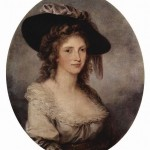
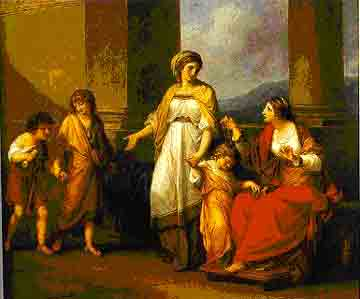
Jacques David
David’s art initially embodied the neo-classicism style that was dominant in France during the late 18th to early 19th century. During this time, he flourished in styling rigorous contours, polished surfaces, history painting and sculptured forms. He abandoned the style due to its primacy and hence set a radical redefinition for the history of painting that drew their themes upon ancient events and distant civilization. David s work was grounded on the new found freedom of expressing emotions after countering neoclassicism.
In his new style, he painted nature in it wild state that later stirred up creative imaginations. That’s not withstanding, David became a prominent artist of history and a virtual dictator of art. This artist was perfect in ethical paintings that focused of the moral climate that existed during the ancient periods Later on, the artist gained interest on romanticism as a student leader in France. He dealt with history paintings that made him to become renown worldwide. He was a landscape artist who achieved dramatic visualization in his pictorial work. Apparently, David had a marvelous mastery of his work as it was depicted on the effect of light and color on his exhibitions.
Some of his remarkable works include the Hay wagon, snow storm and steam boat off a harbor mouth. It is apparent that romanticism influenced Jacques to appeal to the human need to appreciate the work of art since his exhibits held standard s of beauty that heightened public sensation.
With the new romantic style, David got an opportunity to adventure in repertoire subjects through painting that made him get exiled to Belgium in 1816. David History painting emerged as the most notable works of art. Several of his collections are still preserved in world renowned museums as exhibits. Below are samples of David’s works of art.
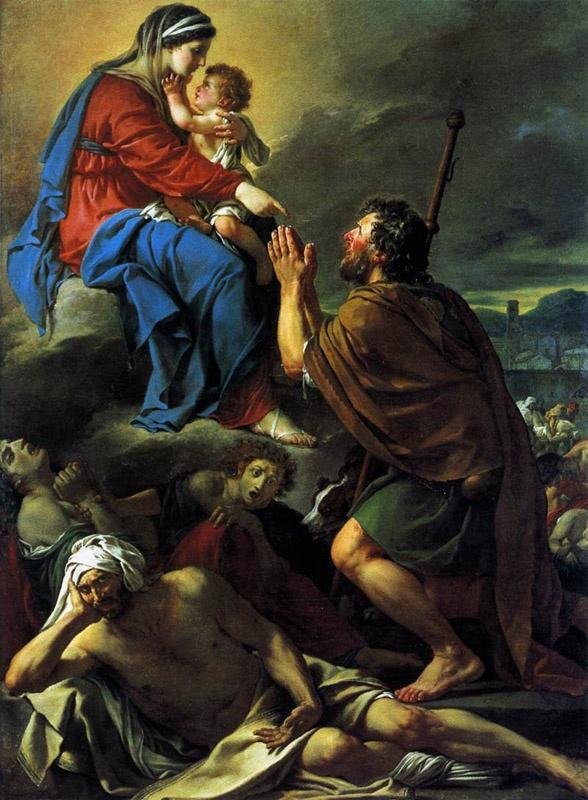
1780
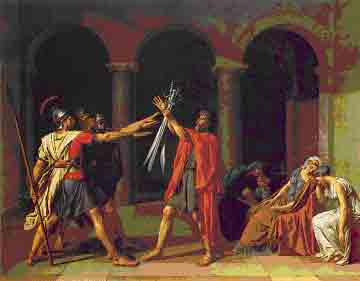
Background of Eugene Delacroix
One of the most remarkable aspects of romantic literature and art history that portrayed the natural world and expressed intense emotion and passion in the history of France came from Eugene Delacroix. Rubin describes Delacroix in his earthshaking article Eugene Delacroix as the most influential and greatest French painter and writer in the history of the French Romantic Movement.
Delacroix (1798-1863) made astonishing use of colors in his paintings which many art scholars claim were very instrumental in developing the impressionist and post-impressionist activities. It is imperative to point out here that his exotic locale was important for his artistic work as not only entranced him, but also provided inspiration for his art and a source for his high and mundane artistic elements.
Delacroix works
Wilkin points out in her publication that one of the most defining literary pieces done by Delacroix was the Journal d’Eugene Delacroix which greatly displays his extensive and substantial literacy. It illuminates and describes his paintings while articulating his view on life, politics and art. As a matter of fact, his artistic beauty as described in the paper has been inspired by writings of Sir Walter Scott, Shakespeare, Goethe and Dante. Additionally, it represents unique contribution to the study of painting history.
Liberty Leading the People
Liberty Leading the People is one of the most epochal and monumental paintings made by Delacroix in response to an event in France described by biographers as a political upheaval of 1830 which almost caused the then reigning monarch called Charles X to be overthrown by the opposition. Spitzer describes the painting as a complex one that is weighed down with spectrums of emotions like despair, anger and grand heroism, and which is pregnant with historical references of the political upheaval.
It is important to note that the painting characterizes French Romanticism which is expressed in complex interaction of colors showing dark shadows and brightly reflective areas. Rubin concurs with Spitzer’s view of the painting and suggests that the complex communication of colors, like rapid-fire brushwork creates vivid contrasts which augments the sense of energy and movement as well as activating the surface of the painting.

Tim argues that the unique style of painting Delacroix’s Liberty Leading the People shows that he did not depend on the subtle and painstaking modulation of colors. Tim hinges this argument on the view that the painting has broken away from the tradition of painting and instead applied traces of shocking, brilliant and pure color pigment.>
From the diagram above, a person can clearly observe primary colors like the yellow, blue and the powerful reds which appear in sharp notes. In agreement, Trapp indicates that the effects in the picture are electrifying and vivid especially when observed against broad gray and brown areas. He concludes that this style faultlessly corresponds with the event and shows how liberty is advancing over barricades that are made of debris, and signify Parisian rebellion.
Modern Nike
Another fascinating piece of art history personifying freedom and standing in the tangled streets of France is the Modern Nike which the French refer to as Marianne. Scholars of history argue that before the 19th century, the largely medieval city of Paris and its streets were developed without a plan and this made it to appear chaotic.
Nicholas posits that the warren, tousled and disheveled streets of Paris with narrow alleys presented major social and economic problems as they slowed down the movement of troops, trade and travel. It is in this crowded area that Delacroix artistic work personifying freedom, democracy and revolution stands.
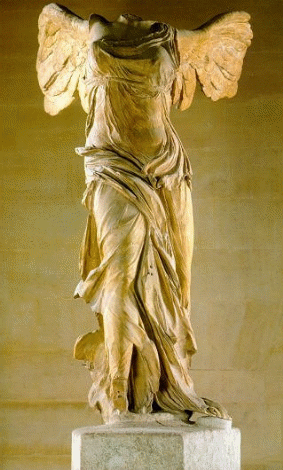
Podro describes the piece of art clothed in a drapery circling the hips and which is being spun by wind as a picture that has a touch of classical statuary. It is on the imitation of Delacroix’s Modern Nike work that certain works like the Hellenistic sculpture with spiraling costume of the late ancient Greek and the Samothrace Nike were found.
Of utmost importance to analysts in the picture in figure I is the idea behind Delacroix exposing Marianne’s breasts, and which analyst posit that since the figure is not a real human being, the exposure indicates an embodiment of an idea. Indeed, Marianne signifies a democracy that was created in ancient Greece.
Delacroix uses partial nudity to refer to that kind of ancient democracy. In addition, the exposed breast depicts the first revolution in France which began in 1798 and created a new democratic state which was seen as an infant which needed to suckle from the breasts of its mother Marianne, and who represented freedom.
Class distinctions
Delacroix describes the phenomenon of class distinction in the history of France in the portrait below that show a menacing crowd that is partially hidden by a heavy smoke from the raging battle. Brown points out that these figures play a pivotal role of representing individuals of very different economic and social positions.
For instance, the man with a jacket, Waistcoat and a top hat falls in the category of middle class citizens while the second figure in a cap and white shirt represents a laborer and a member belonging to a lower class. Delacroix message in this picture clearly shows how in fighting a ruling aristocracy, a revolution has the power to unite different classes.
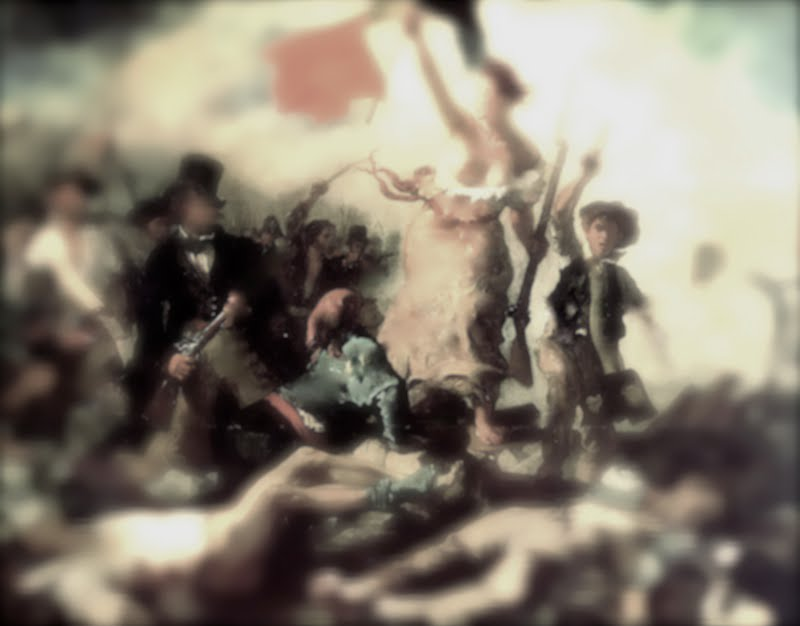
Rebellion and its consequences
The foreground of figure I above shows bodies of two dead people with the one on the left side meant to enrage those who see it. Southgate argues that Delacroix brings the excesses and brutality exhibited by the king’s troops. In essence, the impression created by the painting is that of pure propaganda.
The other dead person on the left epitomizes how the royal troops carry out despised practices of terror. The picture shows an individual in a nightshirt who seems to have been dragged from the comfort of his bedroom into the streets into the streets where he ends up being shot. In addition, there is a dead figure in uniform lying at the right side which Delacroix brings out as a royalist and an enemy who in such instances is vulnerable. At the far right end of the picture there are buildings like the Notre Dame de Paris and the great Gothic Cathedral, which symbolize the power of the king and which in the picture are flying in the tricolor triumphantly.
Conclusion
To sum up, the discussion has clearly indicated that the period of romanticism was characterized by flourishing intellectual movement in Europe in the late eighteenth and nineteenth centuries. Many artists, composers, writers and philosophers responded to the complexity of that age with pieces of art showing the implications of the period. Besides, in the analysis, it is clear that the romantic thought during this time largely reflected organic conception of interconnections, the society and an individual’s life.
Bibliography
Ann-Marie, Michel. “Delacroix and My Modern Masters”. ARTnews 9, no.8(1999): 160- 168.
Barbara, Gabriel. “Performing theory, performing gender: critical postscript”. Essays on Canadian Writing 54, no.6 (1994) 237-260.
Barkley, Wilson. “JacquesLouis David”. Smithsonian 29, no. 5(1998), 80-91.
Bordes, Philippe. Jacques-Louis David: Empire to Exile, Exhibition catalogue. New Haven: Yale University Press, 2005.
Brookner, Anita. Romanticism and Its Discontents. New York: Farrar, Straus & Giroux, 2000.
Brown, Bronwen. “The Cambridge companion to Delacroix”. Reference Review 16, no.1 (2002): 39.
Crow, Thomas. Emulation: David, Drouais, and Girodet in the Art of Revolutionary France. Rev. ed. New Haven: Yale University Press, 2006.
Galitz, Calley. “The Legacy of Jacques-Louis David (1748–1825)”. In Heilbrunn Timeline of Art History. New York: The Metropolitan Museum of Art, 2000.
Gibson, Michael. “Indelibly Delacroix”. The World & I 13, no. 9 (1998): 112-117.
Gossman, Lionel. “Painting the Sacred in the Age of Romanticism”. The Catholic Historical Review 97, no.3 (2011): 597-599.
Kaufman, James & Sternberg, Robert. The Cambridge Handbook of Creativity. New York: Cambridge University Press, 2006.
Laurent, Annie. “Painting and the Journal of Eugène Delacroix”. Revue de Littérature Comparée 281, no.4 (2007): 107-109.
Nersessian, Anahid. “Romanticism, History, Historicisin: Essays on an Orthodoxy”. Studies in Romanticism 50, no. 2 (2011): 377-386.
Nicholas, Williams. “Romanticism and Popular Culture in Britain and Ireland”. Nineteenth Century Literature 66, no. 1 (2011): 122-139.
Pantazzi, Michael. “Memory in landscape: Corot at the National Gallery”. Queen’s Quarterly 103, no. 2 (1996): 286-297.
Pauly, Rebecca. “Baudelaire and Delacroix on Tasso in Prison: Romantic reflections on a Renaissance martyr”. College Literature 30, no.2 (2003): 120-136.
Podro, Michael. “Wrestling with the Angel: The mystery of Delacroix’s mural”. TLS, the Times Literary Supplement 52, no.21 (2003): 30.
Pollock, Griselda. The Female Hero and the Making of a Feminist Canon.” Differencing the canon: feminist desire and the writing of art’s histories. London: Routledge, 1999.
Pontara, Tobias. “Beethoven Overcome: Romantic and Existentialist Utopia in Andrei Tarkovsky’s Stalker”. Nineteenth Century Music 34, no.3 (2011): 302-315,356.
Rosenthal, Angela. Angelica Kauffman: Art and Sensibility. New Haven, Connecticut: Yale University Press, 2006.
Rosenthal, Angelica. Angelica Kauffman: Art and Sensibility. New Haven: Yale University Press, 2006.
Rubin, James. “Delacroix’s Dante and Virgil as a romantic manifesto”. Art Journal 52, no. 2 (1993): 48.
Rubin, James. “Eugene Delacroix”. ARTnews 97, no.11(1998): 155.
Shelton, Andrew. “Ingres versus Delacroix”. Art History 23, no.5 (2000): 726-742.
Southgate, Therese. “The cover”. JAMA 285, no.4 (2001): 375.
Spitzer, Alan. “Delacroix, Art, and Patrimony in Post-Revolutionary France”. The Journal of Modern History 78, no.2 (2006): 496-498.
Stauffer, Andrew. “Dreaming in Books: The making of the bibliographic imagination in the Romantic Age”. Studies in Romanticism 50, no.1 (2011): 213-216,218.
Tim, Wilson. “Delacroix, art, and patrimony in post-Revolutionary France”. Choice 42, no.4 (2004): 649-650.
Trapp, Ferdinand. “The paintings of Eugene Delacroix: A critical catalogue: Fourth supplement and reprint of third supplement”. Choice 41, no.1(2003): 136-137.
Wilkin Karen. “Art: Drawn to Revolution”. Wall Street Journal. Web.